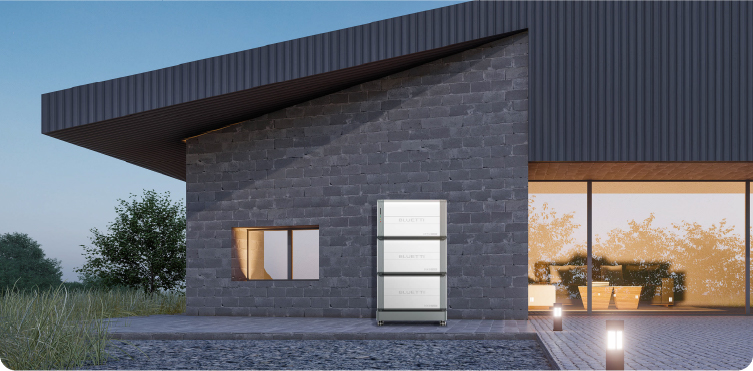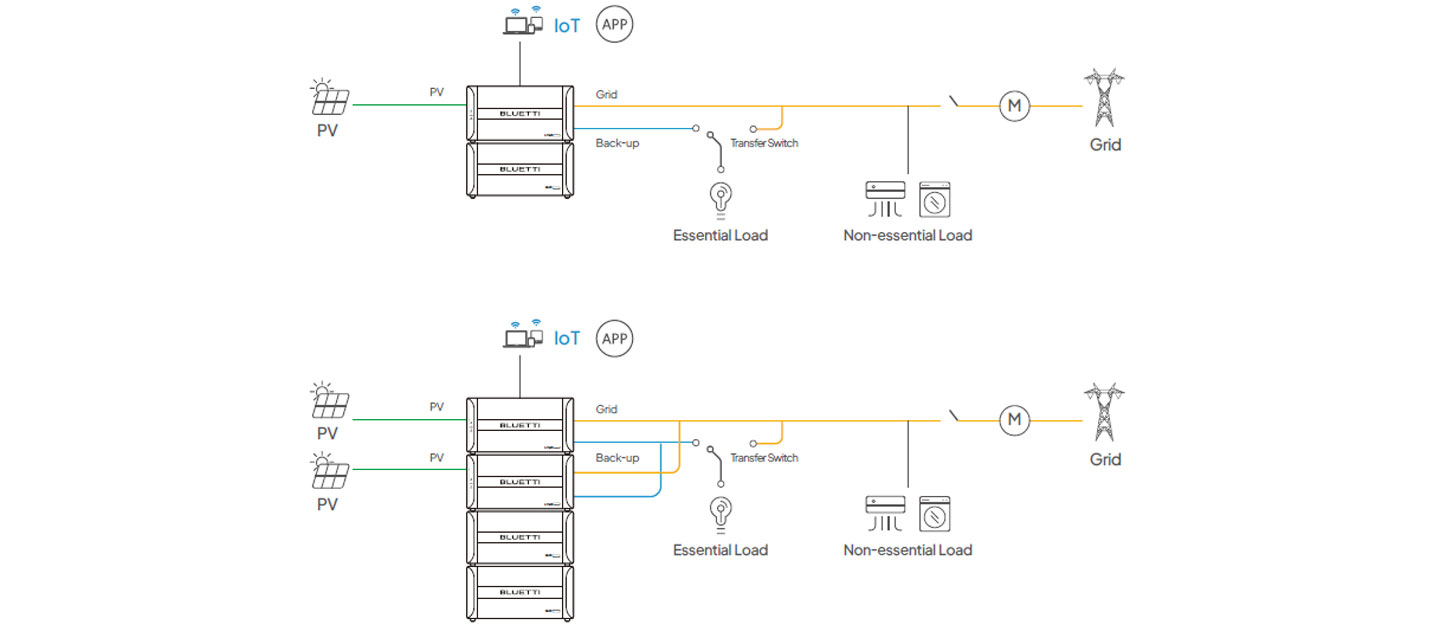United States (English)
Contact Us
Products
Three-phase Output
Dual Votage
Capacity
Recommended MAX PV Array Power



BLUETTI is a leading provider of residential and portable energy storage solutions with patented technology and intellectual property rights. Its EP600 system is a safe, reliable and high-performance product that can store and release solar energy, provide off-grid power and interface with the grid. EP600 can optimize energy consumption patterns and enable homeowners to achieve energy savings and energy independence.
Whether you're permanently off the grid or have an occasional emergency, the EP600 ESS has no problem keeping your high-wattage appliances running at full capacity.




Couple the EP600 with your solar system, and you’re able to power your home with an endless supply of solar energy, living in a self-sufficient way and reducing your impact on the planet.
The EP600 ESS allows you to size its capacity to suit your needs. With just 2*B500 units (4,096Wh each), it can keep your essentials running for a long time during a power outage. Hook up 8 *B500 units, and you can rely on it to run your entire house for days.


5,120Wh / 3,000W~6,000W
Still have questions? Don't hesitate to contact us for more answers.Contact Us
Watch the video: BLUETTI EP500PRO | Unboxing & First use
Watch the video:BLUETTI EP500PRO | Menu&Settings
EP500PRO does not have the capacity expansion function and does not support direct capacity expansion with B300 and B230 battery packs. B300 and B230 can only be connected to EP500PRO in power bank mode for fake capacity expansion. B300 and B230 need P090D to MC4 cable to connect to EP500PRO in power bank mode. Purchase link.
Yes. lt supports 4 UPS modes:
1. Standard UPS (Recommended for regions with unstable grid power supply).
2. Time Control UPS (Charge the system during off-peak hours and power your loads when electricity prices are high).
3. PV Priority UPS (Recommended for regions with sufficient solar energy).
4. Customized UPS (Flexible to choose from the above 3 modes).
Within 20ms.
No, please put it in a dry place. The operating humidity range of EP500PRO is 10%~90%.
Support Bluetooth and WiFi connection APP.
You can use the EP500PRO to charge your devices in cold weather, but please avoid recharging it below freezing. The operating temperature for EP500PRO is:
Charging: 0℃~40℃ / 32℉~104℉
Discharging: -20~40℃ / -4~104℉
The main differences are as follows:
1. AC output power: EP500PRO is 3,000W, while EP500 is 2,000W
2. PV input power: EP500PRO has two MPPTs, a total of 2,400W, while EP500 has only one MPPT, 1,200W
3. AC charging power: EP500PRO is 3,000W, while EP500 is 600W
4. Output ports: EP500PRO has an additional 100W USB-C port and a NEMA L14-30 port (NEMA L14-30 port only discharges low voltage)
5. Charging options: EP500PRO supports car charging and lead-acid battery charging, while EP500 does not support
The main differences are as follows:
1. Battery capacity: AC300 has no built-in battery and must be used with B300. It supports up to 4 B300s, with a capacity of 3072Wh~12288Wh, while EP500PRO has no expansion function and a capacity of 5120Wh.
2. 30A AC output: EP500PRO has an L14-30 output port, while AC300 has a TT-30 output port (low voltage only).
3. Maximum charging power: The charging power of AC300 with two B300s is 5,400W, the charging power of AC300 with one B300 is 3,000W, and the charging power of EP500PRO is 4,000W.
4. Weight and size: A single EP500PRO and B300 are smaller and lighter than the EP500PRO, but the EP500PRO has wheels, which makes it easier to move.
1. The output specifications, voltage and frequency of the generator need to be within the input range of our machine.
2. Does the maximum output power of the generator meet the maximum AC input power of our machine? If not, our machine can lower the maximum AC input current to reduce the maximum AC input power.
3. The output of the generator is a sine wave.
EP500PRO support dual MPPT, each MPPT of EP500PRO accepts 1-6* PV120 / 1-5* PV200 / 1-3* PV350 / 1-3* PV420 solar panels.
It is best to connect all solar panels in series, because the EP500PRO PV input has a wide voltage range of 12V~150V, and the maximum input current is only 12A. The series voltage increases, and the parallel current increases, so the series efficiency is higher. Be careful not to mix and connect different types of solar panels, otherwise it will affect the efficiency and damage the solar panels over time.
The solar input current can exceed 12A. Our machine will limit the current, but exceeding it is equivalent to waste. The current can exceed, but the voltage cannot exceed.
Solar input power can exceed 2400 watts, as long as the total PV VOC of each circuit does not exceed 150V.
Yes, as long as the specifications of the solar panel on DC1/DC2 are within the following range:
1. Total VOC: 12V~150V
2. Total power: Maximum 1200W
3. With MC4 connector
Yes, but please note that your solar roof must meet the following conditions:
1. Total VOC 12V~150V
2. With MC4 connector
3. Is there a micro inverter? The micro-inverter cannot directly charge the EP500PRO. The EP500PRO can only be charged by the micro-inverter through AC wall charging
Note: When the VOC exceeds 150V, the BLUETTl D300S can be used to reduce the voltage to achieve solar charging".
It is not recommended. Due to the unstable wind volume, the output voltage and frequency of the wind turbine will be unstable and cannot be stable within the input range of our machine. Directly charging our machine may be intermittent or even unable to charge.
EP500PRO has two MPPTs. The solar panels on the two channels can be of different types, but the solar panels connected to each channel must be of the same type.
AC maximum charging power 3000W
PV maximum charging power 2400W
AC+PV maximum charging power 4000W
Note: When AC+PV input, PV input will be prioritized
Charging time (estimated) = (Capacity/Charging power) + Trickle charging time.
Trickle charging time for Bluetti power station is typically 0.5~1 hours.
Charging time (estimated) = (Total capacity / Charging power) + Trickle charge time.
The trickle charge time for BLUETTI power station is typically 0.5~1 hours.
Yes. EP500PRO features dual MPPT charge controllers, but please ensure the solar panels in each controller are consistent.
Yes. However, the max charging power would be limited to 100W / 200W. And please setup the "DC input source" to "Others".
1. If the lead-acid battery is equipped with an AC-DC adapter, the battery can be charged from the machine's AC output port.
2. If the battery is charged directly from the machine's DC output port, it is not supported.
You can use the Anderson port of the RV output cable to power the RV. RV cable purchase link.
Power saving mode: when this function is turned on, if the AC or DC of the machine has no load or the load power is too small, the machine will automatically turn off the AC or DC after 4 hours to reduce the machine's self-consumption and save power.
The maximum AC output power of EP500PRO is 3000W. When outputting 120V, it can only output 25A at most, and when outputting 100V, it can output 30A. The L14-30 socket supports a maximum of 30A, but it does not mean that the machine will output 30A. However, ordinary 20A sockets cannot output more than 20A, so the L14-30 output port is needed.
Yes, as long as the total load power does not exceed the maximum output power of the machine.
Runtime = 5120Wh × DoD × η ÷ (load power+self-consumption power)
Note:
1. DoD refers to the Depth of Discharge, η is the local inverter efficiency. DoD=90%, η=90%.
2. The above data is for reference ONLY.
For details, please refer to "how to build a partial backup system with EP500PRO".
1. When the SOC drops to 5%, charge the product immediately.
2. Before storing the product, charge it to 60% SOC to maintain optimal condition. In addition, power off the device and disconnect all electrical connections.
3. Store the product in a cool and dry place, away from flammable or combustible materials and gases.
4. The power station can be safely stored in a temperature range of -20°C to 45°C (-4°F to 113°F). However, if stored for more than one month, it is recommended to keep the ideal storage temperature around 30°C (86°F).
5. Fully cycle the product every 3 months to maintain the health of the battery.
Not recommended, as long-term placement may cause the internal structure to loosen. It is recommended to place it upright.
Bluetti bank receivables account notice
To partners:
Bluetti in order to ensure the accuracy of financial information, increase the trust and exchange between partners and Bluetti, to avoid the risk and the possibility of fraud in the transaction process, and ensure that the funds are not lost, the notice is as follows:
All business payments must be transacted using corporate to public bank accounts. Bluetti expressly prohibits any cash, personal accounts, third-party company accounts, etc., for collection transactions.
Since the date of this notice(2025/01/15), all partners are requested to transfer all funds related to Bluetti business into the public account. If other accounts need to be used for payment due to special circumstances, Bluetti will issue the account change confirmation with official seal and issue it through www.poweroak.net, otherwise, Bluetti will not bear any loss and liability arising from the transfer to non-designated accounts.
If you have any questions about the transfer process or the specified account information, please feel free to contact Bluetti. Contact email [feedback@bluetti.com]; Contact address: https://www.poweroak.net/contact-us.

عربي
عربي
中国大陆
简体中文
United States
English
France
Français
Deutschland
Deutsch
Italien
Italiano
日本
日本語
España
Español